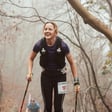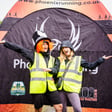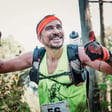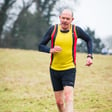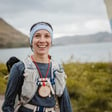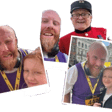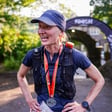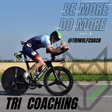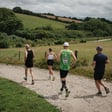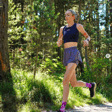Become a Creator today!Start creating today - Share your story with the world!
Start for free
00:00:00
00:00:01

Stuart Gordon& Dr Susie Cooper.
Episode #38
Stuart Gordon - Sports Therapist of 30 years, with clients all over Europe including players from clubs like AC Milan.
Dr Susie Cooper - GP, Rheumatologist, Sports Med Dr & endurance runner who defied her surgeon after rupturing her Plantar Fascia and returned to running.
We discuss:
How to and why runners should strengthen their feet?
Gait symmetry.
Insoles: Orthotics vs Barefoot Science.
Plantar Fasciitis, tips to prevent and for rehab.
You can follow All About Balance on:
Get 25% discount and free shipping of Barefoot Science insoles on this link
Transcript
Introduction to UK Sports Chat Podcast
00:00:00
Speaker
Welcome to episode 38 of the UK sports chat podcast. We finally built up the courage to have a go at our first video podcast rather than audio. Our guests today are Stuart Gordon, sports therapist of 30 years with clients all over Europe, including AC Milan footballers. Stuart is the UK distributor of Barefoot Science Insoles.
Dr. Susie Cooper's Journey and Insights
00:00:23
Speaker
We also have Dr. Susie Cooper, GP, rheumatologist, sports medical doctor, and endurance runner. And I do believe that Susie defied her surgeon after rupturing her plantar fascia and returned to running. How are you both? I'm very well, thank you. Lovely to speak to you, Joe. Nice, thank you.
00:00:44
Speaker
Yeah, good to be here. Thank you for coming on. I've given you both a little intro there, but would you like to introduce yourselves to everyone for me, please? Ladies first. Go ahead. Okay. Well, I'm Susie Cooper. I am a GP, a doctor and a GP, and also work part-time as a rheumatologist, which is part of general medicine, which deals with bones and joints for
00:01:12
Speaker
those of you aren't aware and that's what I do for work. I'm a mother of four children and I've run pretty much all my life really since I was a teenager, nothing major until really in my 40s I decided to step up the distance really and then joined a running club and then it sort of got a bit out of hand as these things do so that's the kind of thing I do. I've also got a sports and exercise medicine diploma. I'm fairly sort of
00:01:41
Speaker
I'm very interested and slightly obsessed by exercise of any form to help with physical and mental illness. It's a massively important part of medicine. So I suppose my sport feeds into my work in a huge way. And I think it's so much part of life as well. Which club are you a member of, Susie? Hazelmere Border Athletics Club, HVAC. Fabulous local club.
00:02:09
Speaker
You must get some questions, anyone's got a niggle at the club, you must be. They're pretty good, to be honest, they will, but I wish they'd asked me more, you know, but I'm not their club doctor, we don't have, we're not that kind of club, we don't have a club doctor, but it's lovely to help if we can, but on the whole they've got fantastic coaches, we're very sensible.
00:02:30
Speaker
And I always hoped they would ask me. But to be honest, I think, you know, I'm always there if they need it, but they're pretty sensible bunch, to be honest, other than the fact they run so far.
Stuart Gordon's Experience and Barefoot Science
00:02:40
Speaker
And too fast.
00:02:44
Speaker
You win. Welcome. Thank you very much, yeah. Just before I introduce, I don't know whether Susie knows this, but I actually was a member of Hazen & Border Athletic Club going back in about 1968, where my dad and my brother were runners as well. And so I started going down there, obviously as a very young child at that age.
00:03:09
Speaker
They had a fantastic guy who set the club up, I think, called Bill Sykes, who was a British Olympic team manager. And at the time they had a fantastic guy, he was an absolute hero to us locals, a runner called Martin Billum, who competed in the Mexico Olympics in the 4x400 team.
00:03:27
Speaker
It was, and I've been up and down to there. I went to school next to the, where the running club is. So I've got a big connection with it. Treat quite a lot of the runners, the members that are over the years. So it's really nice to have that funny little loop connection. But, um, so yeah, so I was, yeah, it's really nice. So just as I said, I've been a sports therapist nearly 30 years. Um, I actually trained originally in, in, uh, sports and recreation.
00:03:54
Speaker
after going to college and everything and worked in that industry for a couple of years, managing squash club in London and working in a holiday and country club up in Lower Stough coaching those different sports. And I played a bit like Jar, I think we've got a shared background in football, played a lot of football. Yes. And for me, running was sprinting.
00:04:14
Speaker
I sprinted for the county as a schoolboy and did long jump for the county, but the long distance stuff was for pre-season football training purposes mainly for me. But retrained after a while, I went into different business, retrained then as a sports therapist. And I just love doing it. I've been doing it for 30 years, get an absolute joy from it. And then about seven or eight years ago, after I've been fitting people with orthotics for about 20, 25 years nearly,
00:04:41
Speaker
I came across this product called Barefoot Science Insoles, which transformed the way I looked at feet and movement and the chain of movement through the body. And I also trained in or studied the new research coming out on the myofascial tissue function in the body. It's a big area that's evolved over the last few years.
00:05:01
Speaker
And those two things came together because the barefoot science insoles and how we function using fascia are actually very, very closely aligned. And then about two years ago, I took on the UK distribution of barefoot science insoles and really decided that a great area to get this out to for benefit would be for the running community.
00:05:22
Speaker
So I've done working with you guys, hopefully doing this sort of thing, get the message out there about the importance of how these insoles work to help prevent injury or reduce injury risk, recover from injury, as in Susie's case, it helped, and for performance enhancement as well. So that's what I do. Thank you. And that's a little bit, that is how you two met really, isn't it? Because Susie, we were speaking before we started recording, but you picked up an injury.
00:05:53
Speaker
I did, yes. I was doing what you shouldn't do as a runner, which is when something hurts, you keep going. And I was trying to get a good time for Edinburgh Marathon. And in fact, I never got the good time because I didn't actually do the marathon. Because as time went on, I was doing well, I was pushing the speed, I was doing well with the training program, but my left foot was hurting. It was hurting all along the bottom of the sole.
00:06:16
Speaker
And I've seen loads of plantar fascia as a doctor. When I first started being a doctor, we used to inject the plantar fascia with steroids, which is never done now, because that's the worst thing you can probably do to it. But, you know, we used to inject it and do very little else. That's how things have evolved, I'm pleased to hear. So that was back in the sort of 90s, late 90s. That was
00:06:40
Speaker
what people did for plantar fasciitis. There was no talk of treatment of the injury with shoe inserts and orthotics and all the rest of it. So I kept running. I actually thinking this is actually plantar fasciitis. To me, it didn't feel like it. It just felt like pain all along the bottom of my, you know, right inside my instep. And I kept going, kept going, and then eventually it was too painful to run. And the pain didn't go away. So then you know you're in trouble.
00:07:09
Speaker
eventually made my way to a foot surgeon, who is a delightful lady, and she said, well, MRI your foot, which of course what all doctors do is they like to MRI and CT and image everything, which is the right thing to do. Although I have to remember that MRIs don't always, they might tell you what is structurally going on, doesn't tell you what is actually going on functionally. And rather to my disappointment, I was hoping it would just show a bit of inflammation in the plantar fascia, because by then I'd realized,
00:07:38
Speaker
bit of inflammation going on, it actually had a complete rupture of the plantar fascia all the way down it and across it, so longitudinally and across as well. So she just said to me, that is going to take a long, long time to get better. You can't run. Well, I realized that I couldn't run at the moment. I was then told that I couldn't run ever again and I ought to change my sport.
00:08:04
Speaker
And this point I thought, I don't think you quite understand, that won't work. And I sort of ignored that and thought, well, there's something I can do about this. And I just strapped my foot up a bit and got on my bike. I am a cyclist, but I don't love it as much. So I got on my bike, we actually, my husband and I got new bikes and we cycled a lot.
00:08:22
Speaker
And it got better, but it took about six months to fully recover, well, as it recover enough to start training again. And I just started doing bits of running, walking, what have you, and realized it was getting better, but still ached. And I think it was as, and then I found my complete surprise and
00:08:37
Speaker
Very pleasantly that I could run more and more and that actually it wasn't getting worse. I could run on it So I was not you know I was able to run and
Understanding Barefoot Science Insoles
00:08:46
Speaker
I was picking up the distance running with my friend Philomel who is a very good runner and she runs far faster than me, but we were going on a nice run which was around Longmore in fact, we got on to Longmore around the track and met Stewart and
00:08:59
Speaker
And we got a bit lost in terms of which way to get out again in order that our run was not going to become an ultra at that point. And said, Tim, do you know where we should go? And he said, yes, of course I do, because I know this area. I live here. And it was at that point that Stuart said, by the way I run, I have this little company.
00:09:18
Speaker
you might be interested to know what it is. We just got chatting. It was very nice. So Stuart not only told us how to get home without making it into an ultra, but I then contacted him afterwards. So that's how it started. And then I went along and got some of the barefoot science insights. It's an affliction for me, Joe. Susie and her friend were standing at a gate trying to keep warm by just gently jogging on the spot. And I noticed that she was favouring her foot slightly.
00:09:47
Speaker
I can't, it's like a form of Tourette's, you know, you can't not say it. So I said, what's wrong with, you know, something wrong with your foot or your calf? And Susie looked at me and I said, why did you say that? And I said, well, this is what I do. And she said, well, I'm a doctor. And then we got chatting and transpired. I think at the time where Susie was working was in a physio practice who I know, and funny enough, who actually stopped the insults. It was my first stockist of the barefoot science insults.
00:10:12
Speaker
A bit of a place called Hinted in Surrey. So anyways, then as Susie said, she contacted me and we popped the insoles in. And I think, and I hope I'm right in saying that, you know, you've had a pretty positive response with them in terms of production of paint. Yeah, yeah, definitely. Definitely. Definitely. And in fact, my husband then got some as well, as he was getting problems with his tennis. He's not really a runner. He's helped his tennis. So that's interesting. So let's go back and
00:10:42
Speaker
If you noticed the function of Susie's foot, is that what you're saying you noticed when she was... Yes, she was just favouring her foot. She was running. Is that right? She was trotting on the spot, trying to keep warm and looking around, thinking, where the hell are we? And I just thought, that's it, but something's going on there. As I said, it's like a form of Tourette's. You can't not say something. I keep accosting people out on the trails around the area when I'm walking with dogs.
00:11:09
Speaker
I know what you do as an occupation. It fascinates me though. I've walked into a physio's room before I had a friend who's a physio and he's gone, your leg's short and your pelvis is out and you've only been in there a couple of seconds. It's fascinating. I think we're all asymmetrical, aren't we?
00:11:25
Speaker
we're all asymmetrical and none of us are perfect. So I think we have to remember that when we're doing any of these things and running puts so much pressure on the feet and the structures that you do, if there is any mild asymmetry, as you push the distance, it's going to be accentuated, isn't it? Whereas one size starts to weaken. The asymmetry thing.
00:11:47
Speaker
I know the product, Stuart. Sorry to talk over you. Let's go back and explain what the product is and what it does then, because we mentioned asymmetry there. Let's go right, would you like to do that? Yeah, I'll show you. I've got a nice bright coloured orange one here. So it looks like just a straightforward simple insult. And I hope on this bit here, you might be able to see the key bit to it, which is this bump.
00:12:12
Speaker
And the bump sits in what's termed as the mid arch of the foot. So we all know we've got this longitudinal arch on the inside, medial arch and a longitudinal lateral arch. We also have what's termed as a transverse or metatarsal arch which goes across the foot. So this bump sits in between those three arches. And it's also the point which when we load down onto our foot, that's where our center of mass travels down through the body. So it's the load bearing part as our weight travels down when we land on the foot.
00:12:41
Speaker
Now underneath the insole there's this socket and a chiropractor
00:12:48
Speaker
About 25 years ago, a chiropractor in Canada came up with this idea, and he wanted to try and stimulate a system called proprioception, which is a system that controls balance, it controls facial awareness, and it controls what's called the stretch reflex, which is our gift to injury avoidance. It's a system that puts the brakes on when we're extending beyond a certain range. They're really, really important for all sports and running included.
00:13:13
Speaker
So initially he wanted to set this up to improve balance because he knew that if we pop some stimulation to the underside of the foot, it would improve the amount of neural activity going up through the body to the brain and help with balance.
00:13:27
Speaker
But what we've seen as we've carried on doing various tests over a number of years using different equipment, this thing called surface electromyography, there are lots and lots of different gate analysis machines, there are force plates that you can measure balance, you can measure asymmetry and movement. And this is the really interesting thing, I think, from a running point of view. And a lot of research that's coming out now is saying that asymmetry is the
00:13:54
Speaker
greater cause of injury and running inefficiency. So the closer you can get to a symmetrical balance movement, left side, right side, the better you perform and the less likely you are to create injury. And as you know, as a for instance, there was a study done in a big study actually in the Israeli army and a lot of soldiers get become the beginning pigs for lots of studies. But what they saw was over a period of assessing all the soldiers at their initial stage of recruitment was that
00:14:23
Speaker
When they then went out and did their training and got injured, it was those who had a greater than 10% asymmetry differential between left and right side in contact time. So that's touch and go. That's your foot landing on the ground, managing its landing and pushing off. So anything greater than 10% resulted in 75% incidence of lower limb injury.
00:14:46
Speaker
So off the back of that, the US Olympic Committee, I mean, it's huge. Yeah. And actually, when you when you look at any one of my blogs, I've just putting up about this, when you look at running as a as a community, the estimate is there's somewhere between 70 and 75% of runners get injured every year. So when you see that, yeah, that's greater than 10% asymmetry, you've got a 75% chance of injury, you kind of have to start making connections between the asymmetry and the injury as in the running community.
00:15:16
Speaker
So we work with Barefoot Science. We work closely with a gait assessment system called Octogait, which uses infrared technology, 96 infrared beams going from one side of a treadmill to the other. Or you can have 100 meters strip of this if you've got enough money to buy all of it. But we get something on a treadmill, and we can assess the asymmetries in contact time and stride length and see what that difference is. And if somebody's greater than 10%,
00:15:44
Speaker
then we need to help them and we need to help them by a variety of things. So one of the things that we do is test them barefoot, see what their natural degree of asymmetry is, then we look at them in their trainers. So you see whether the trainers are helping or hurting them.
00:16:01
Speaker
And quite often, the figures go up, they get worse. So then you try different trainers and find the best trainers for that person. So when we look at gate assessment, assessment on its own isn't enough.
Technological Advances in Reducing Asymmetry
00:16:13
Speaker
We have to look at them trying to help people and help them
00:16:16
Speaker
with proven data, not just looking at them and saying, okay, well you put an orthotic in or you put a pronation control trainer in or a motion control trainer or a support or a cushioning or whatever it is. Unless you reassess them afterwards, you don't know that it's making a positive benefit. It might actually be making it worse.
00:16:34
Speaker
I'll give you an example. She's actually retired now, but she was an Olympic snowboarder for Canada. She was put through this very recently with six different pairs of trainers. Now, out of competition now, her natural balance barefoot natural asymmetry was about 6%, which probably was higher than it would have been when she was competing and training more regularly and doing stuff. But 6% is still pretty good.
00:17:01
Speaker
When she put these six different pairs of trainers on, the asymmetry figure went from 7% in one pair of trainers up to 28% in the worst. Now, the 28% pair of trainers were ones that have been recommended to her by her Olympic coach.
00:17:19
Speaker
at some point in her career. So with all the best intentions, you know, he'd looked and looked at what was happening, but those trainers would have tripled it. And we've seen this time and time again. So the key thing is we look to try and retrain asymmetry. And what happens in the assessment is barefoot, shoes on, find the best shoes. And then this chap, Peter Gorman, he's a top chiropractor and he's a co-owner. He invented the polar heart rate monitor.
00:17:48
Speaker
all those years ago and he then got involved with Octogate five or six years ago as an assessment system because he felt it was something that could be used to treat and improve or reduce asymmetries and improve gait. So he tried barefoot science and what he found was in nearly 3,000 studies now, cases now, that it actually reduces the asymmetry almost immediately, gets somebody on the treadmill wearing a pair of these and the asymmetries come down.
00:18:16
Speaker
So he then pops them in that. Okay. And what happens is, I don't really can see it, we have these, these six or seven different levels of plug that pop into that socket on the bottom. So I'll just get a couple out. So that's, that's number one, the little pink one, and number four is the green one. They're the same shape. You can see that the number one is the thinnest number four is quite chunky. Does that come through on the picture? Okay.
00:18:43
Speaker
Yeah, and then we go up and- Yeah, so you start with number one. Always start with number one. And- To start off with a very- Exactly, yeah. So what we're trying to do is to generate some stimulation to those sensory nerves, the proprioceptive nerves on the sole of the foot. And when somebody gets used to that, and they barely notice the insole after a week or after two weeks or six weeks, it doesn't matter. It's just as long as it takes for their brain to get used to that amount of stimulation,
00:19:12
Speaker
Then we'll move up to the next level and stay with that for as long as it takes. Eventually you get up to plugs that are sort of that profile or even bigger still for number seven, that profile, but they're thinner as they get the last two or actually your last three are thinner than the number chunky number four. So we're spreading the contact surface area.
00:19:32
Speaker
So that's how they work. You have this increasing amount of stimulation on a progressive. It's rather like a training system. If you go to the gym, you start off with light weights, or if you start running, doing the couch to 5K, you walk a bit, you run a bit, you walk a bit, you run a bit more. It's the same with these. You add some stimulation, then when the body can cope with that, you add a little bit more stimulation. I actually like to refer to them as an in-shoe training system, really.
00:19:57
Speaker
That's how I tend to refer to it. Yes. So this is what you were referring to. When you hosted the hour on Sunday, you asked a question about foot strength in it. So non-medicalized me, dumb this down for me. So you're saying that this insole and those different levels are a workout for the muscles in your feet. And when your feet workout and get stronger and go through these levels, there's more asymmetry, which will reduce your
00:20:28
Speaker
injury, your chances of being injured. It's a combination of muscle strengthening and neural stimulation. Muscles can only work if they're given information. They have to have a switch on. And what's happened with the way that feet have been working within shoes with lots of cushioning and maybe are not able to spread as the foot lands, don't get that stimulation to switch on the nerves. Therefore, the muscles don't get given the information they need.
00:20:58
Speaker
to perform their job. Now, when we talk about the muscles in the feet, there are 20 small muscles, what are called intrinsic. That simply means they start and finish within the foot, whereas extrinsic, and the muscles coming down from the calves, they come down, wrap around the ankles, wrap around the heel, and then into the foot.
00:21:18
Speaker
So what we're saying is that those 20 intrinsic muscles have got a bit sleepy. They're not getting fired up. They're not getting information to tell them to work. So they've become weak and unused. We need to fire them up and work them. And we need to do that from within the shoe. So if you were running barefoot on the sand, you'd get that contact. You'd get that information, but that's not practical for everybody. You know, we love trainers. They look great. We want them to feel comfortable. We want to be running on all sorts of different surfaces so that we have to be realistic that, you know, however
00:21:48
Speaker
Yeah, there are people out there who happily run barefoot and, you know, fantastic, you know, no credit to them. But that's not going to be the majority. The majority are going to want to stay in their shoes and we need to provide them with that same effect, that same stimulation from within the shoe. And that's what this system very cleverly does. Okay. So I'm thinking gymnasts on balance beams and those kinds of things. They're doing this all the time, aren't they? Did you see the post stuff on the street about that?
00:22:19
Speaker
Yeah, that's where I got that from. We commented about gymnastics. Yeah, that was really good. Yeah. So a question for you, Susie. Well, for you both, this one, how many people do you see that are over that 10% in asymmetry? Do you know? And Susie, how did
00:22:44
Speaker
How long did it take you to work through those levels? What level are you on? And how is the insole now a part of your prehab and rehab, I suppose? Because it sounds like it's not just for rehab this. No, potentially not. I mean, I think everybody's different, aren't they?
00:23:01
Speaker
Go back to your first question, how much asymmetry do I see? Remember the majority of people I see, because my work is mainly in the NHS, come in with problems that are really not really elite running or whatever.
00:23:16
Speaker
or endurance running related. But the majority of people that end up in the rheumatology clinics and in general practice are musculoskeletally quite compromised, shall we say. They're not always as healthy as they'd like to be. And that's for various reasons. They're actually unwell for other medical reasons.
00:23:36
Speaker
you examine people generally we're all a bit you know whether it's your shoulders the way you sit your spine none of us are perfect specimens and you what's wonderful is when you do see someone come in who is very symmetrical and very well trained so the kind of people who really do seem to have better alignment will be your say your dancers or your
00:23:58
Speaker
or your people do a lot of yoga. Now is that because they always were in the first place, it's made them dancers and so on. And I think there's a danger with us runners is when you run, all you do is run and you do a few stretches and all the rest of it and you keep running. Now, when you're doing something at a high speed and you build up the muscles for that, you can almost at a low level, as we all know, you can get away with it. But the further you push it,
00:24:26
Speaker
then the asymmetries will come out. Now that, when they come out, depends on where you're starting from and how bad the asymmetry is, for sure.
Comparing Insoles and Orthotics
00:24:35
Speaker
Now, so I don't know any evidence based on all of this, but that's sort of common sense more than anything, isn't it?
00:24:42
Speaker
So a lot of people, you look at their knees, for example, alignment of the knees, whether it's vagus or varus, you know, that that will make a difference to their feet as well. So it's never going to be just the feet, it's going to be the knees, the hips, the spine, everything. So yes, majority of people, I would say, not only are they not symmetrical, and, you know,
00:25:05
Speaker
And then also that continues and the older you get, the more and more that gets accentuated. So we all sort of know that. So yes, a lot of people are. I would say we all are, really, unless we're very, very lucky. So that's that question. And in terms of the orthotics, the barefoot system, I used it really for recovery.
00:25:26
Speaker
and it really, I think it really helped. It's very difficult to tell when you've only tried it once and I now run with new trainers and actually I don't always use these. I've got to the point now where I don't use them and if I'm doing a long run I'll actually support my plantar fascia by strapping it to be really
00:25:46
Speaker
careful. But I think there's a role for them in recovery and probably maintenance as well. I'm not using them for maintenance all the time. I actually use them to walk around in and then I use my running shoes and strapping when I'm doing long distance. But that's just me. You find your way to sort of do things. I use them as a recovery. My husband uses his all the time for tennis. I'm going to jump in here and say, Susie, you should be wearing them.
00:26:14
Speaker
because you strap that foot and then you're going to basically stop it from working correctly. You're strapping it in a position where it can't work. I use a variety of ways of dealing with it. But yeah, there's great advantage for doing it. But I haven't actually tried to actually. You need to get them back in because you said to me the other day when we spoke, you're actually starting to get some pain when you're on your longer runs.
00:26:40
Speaker
And well, you know, there's the clue. Get those insoles back here and get used to them because the muscle can openly work if it's switched on. And when your foot gets tired and the muscles get sleepier and your gait will start to struggle a bit, you've got to maintain that stimulation to the nerves. And you know, the point about the insole and the proprioceptive stimulus, you know, the foot will become self-supportive. But
00:27:11
Speaker
Why would you not keep that in there if it's going to keep firing your system up? As I say, we have SELG, surface electromyology, we can measure the neural activity going to muscles.
00:27:24
Speaker
And what we know is that when you put barefoot science insoles in, an asymmetry in that firing levels off over a period of weeks and months. So you retain better symmetrical firing of muscles. That will help you move better. It also increases the amount of firing. I mean, this is a crazy figure, but we have one young woman who was a top CrossFit athlete. She was in the world's top 25.
00:27:46
Speaker
but kept getting sacroiliac joint problems. When she was assessed, she had one hamstring firing considerably more strongly than the other and one glute virtually doing nothing at all. Over a period of four months, her glute firing increased by 319%.
00:28:04
Speaker
Now that's not a guesstimate, it's a factual figure. And when we look at asymmetry of movement, and I totally agree with what you're saying, and everybody that comes in to see me in my treatment room pretty much is asymmetric in one way, shape or form.
00:28:20
Speaker
But the point is that when you look at somebody, and we've tested this, we've had some of the best biomechanists in the world, look at somebody on a treadmill and you say to them, right, what degree of asymmetry do you think they got in their stride length or their contact time? Using eyeball, you're vastly experienced. And I've been doing it for 25, 27 years. I'm really good at it. You can't get
00:28:42
Speaker
Closer than 16%. That's the best anybody's got down to when measured against the technical equipment that will show you down to the nearest point of the percent. And if you think about it, 10% or more asymmetry, you've got a 75% chance of injury. If looking at somebody eyeballing them on a treadmill, the best you can get down to is 16%. It's not good enough for us to be able to say, oh yeah, you're a bit asymmetric, but don't worry about it.
00:29:10
Speaker
your body will compensate. Well, it will. It will compensate. And the compensation is what will cause the injury, eventually, sooner or later. So the best athletes, those ballet dancers, ballet, you know, oh, my goodness, ballet dancers get battered. But, you know, the best athletes in the world are the ones that are best at compensating. They will have... Yes. There was a world number one tennis player who got injured, came back,
00:29:37
Speaker
got stuck at 88th in the world. He couldn't get past it. He was, when he was assessed in this way, he was functioning at 8% asymmetry, which for a lot of us would be great. So he wasn't in injury danger zone, but in terms of performance zone, no good. So when put through some retraining using the, and so I was using the gate retraining system within about five minutes on the treadmill, he was down to 0.5% asymmetry.
00:30:01
Speaker
and within three months he won Wimbledon and was back at number one in the world. So it's important to get this balance right and get the safety of the shirt. I'm conscious of time. So let me ask you, I've got a couple more questions. How are these different to other insoles? So orthotics, for example, I've had orthotics, they work. I remember having them and then having some lower back pain actually, so I felt like
00:30:31
Speaker
aches and pains, moved to different countries on my body, but how are they different? And two other insoles that are right there that are spongy and claim to be very comfortable. A really good article on the website and www.allaboutbalance.co.uk under our blog section, there's a really nice article with a terrific medical doctor from the States who's a military guy, champion endurance runner,
00:30:59
Speaker
running coach. He's a committed barefoot runner as well, but he wrote an article about all the different types of insoles and footwear. So we have cushioning, some that provide cushioning, some that provide support, some that provide arch support, some provide heel cushioning. Then you look at the off-the-shelf orthoses, which maybe provide, again, some of those supports, but also suggesting that they help prevent overpronation.
00:31:23
Speaker
and you've got all these different things and then orthotics and a dictionary definition, a Webster's definition of an orthotic is that it's a brace or a splint to support the foot in a particular position. And again, I've fitted orthotics for many years and at the time, because I didn't know any different, they did a job and they do a job. There's unquestionably a place for them. But when you assess somebody using this high-tech equipment,
00:31:50
Speaker
they wear orthotics in a reassessment, you will see some changes. And it may be in different aspects of the gait movement. What doesn't change, particularly positively, is the asymmetry figure. So they might change what's termed a single-leg stance or swing phase or whatever, but they don't change the asymmetries between the left and the right side. So the fundamental difference between all of those different things
00:32:16
Speaker
and barefoot science is that specific target of stimulating the proprioceptive nerves and strengthening the foot. Because as an invention, the human body is phenomenal. It's got the most astonishing ability to absorb shock as the foot lands. It's our first part of our shock absorbency system. And as your foot comes down, it should lengthen and flatten and load tissue into those springs in those little muscles in the foot, ready for them to recoil to help push you forward.
00:32:44
Speaker
But if it's cushioned and supported and it can't do that, then the muscles don't work. So what we're saying is let's get that stimulation back into those muscles to make them work in a different way to anything else by firing up the system to function better.
00:33:01
Speaker
And Stuart, what do you think about, what I often do is walk around, say bare feet, and then I'll be doing things, you know, out and about, around the garden, whatever, and then I'll put them on in my trainers, whatever I'm wearing. And then I really feel the benefit. So what do you think about them not wearing them all the time? Because I find that not wearing them all the time. So when I go to work, I can't necessarily fit them in the shoe.
00:33:27
Speaker
work shoe, so I can't wear them, some work shoes I can, and then I'll come home and think, oh, I'm going to put the trainers with them on. And then I really feel the benefit. So I want to make an intermittent
00:33:40
Speaker
Yeah, I wonder if the intermittent use that I'm sort of doing, I quite like that. Now, that's probably just me. Yeah, I don't know, but I quite like that, you know, I quite like some normal things and okay, my plantar fascia is not even, you know, my foot isn't hurting, but I'll put them in and it actually, I think, oh, that's quite nice. So I wonder if, I mean, I suppose it is doing that, isn't it? Stimulating it and waking it up again. Yes, it's precisely that, and then it gets away from it. It's quite interesting.
00:34:10
Speaker
I mean, I suggest to people you wear them as much as you can. And again, I had a young woman, a runner and a CrossFit athlete who, well, she couldn't run, basically. She had shin splints and she couldn't run more than a hundred litres without being in pain. So we got her in a pair in her trainers, but of course they were full length. You can have full length or three quarter length. Now the full length she had in her trainers, but of course she was only in those for about three hours a week. So she felt great. It was actually helping her lifting,
00:34:39
Speaker
it wasn't helping her running. So she then committed to buy a three quarter length pair and wore them all day in her work shoes or whatever else she was wearing. And within three weeks she was running pain free. Um, and she clocked up a 5k without any pain. She couldn't run a hundred meters before without being in pain. So that was the difference between getting that presence of the bump and the stimulation going and firing up those muscles. Now, if she goes without,
00:35:06
Speaker
For a while, she's okay. But just like any other training system, if you go to the gym every week, three or four times a week, and then you go away on holiday for a few weeks and you don't go to the gym, when you go back, you're not gonna have the same condition. If you stop running for a few weeks, you don't go back and run a marathon first time out. You might do a half, depending on what level you're at and what your endurance abilities are. But you always have to ease yourself back into activity if you haven't been doing it.
Tips for Plantar Fasciitis and Foot Health,
00:35:30
Speaker
And we say, if you stop wearing these for a while, for a performance point of view,
00:35:35
Speaker
then you need to ease yourself back into that. You might have to drop down the plug level. If you're in level six, you might have to drop down to level five or to level four to rebuild up the strength again and the stimulation until you can cope with those other upper levels and away you go. But it is a performance enhancing as well as injury recovery and injury prevention. So it covers all angles by getting that stimulation going. The stretch reflex is key.
00:36:06
Speaker
Final question for you both, because there was a, Susie Wen Stewart was on our tweet chat hour on Sunday. We had a lot of people, and we do see this a lot, who are suffering with plantar fascia. So I can't let you both leave without asking you for your tips for people out there on what they can do to help with that condition.
00:36:28
Speaker
Yeah, it's very difficult, isn't it? Because it's not something I'd ever had until I got it. You know, I didn't get a bit of it, I just got it. And why do some of us get it? I'm sure Stuart's got more an opinion on this than others. But it's like all of these running things, it will be building up.
00:36:46
Speaker
And I think it's got to be that we change the way we're using our feet. And as Stuart says, you know, stimulating the muscle to contract because it acts, it's not really a muscle, it's not a tendon, it's a funny old thing, the plantar fascia. So you have to treat it almost like
00:37:05
Speaker
a tendon if you like, just keep stimulating it. But you need to strengthen, you need to look at the whole of the body, you need to look at the asymmetry and so on. And I think stretching after, I mean, we all do it, we try to do it and we talk about doing it. I think it's really important to stretch. I think it's really important to get the soleus muscle stretched and not just the hamstrings and so not just the quads, you know, try and really do good stretches. I'm quite a fan of yoga in terms of
00:37:36
Speaker
trying to use all of your muscle groups, you know, stretching out everything. And not you're not going for massive stretches, you're just trying to put all the joints through the range of motion. And I think as runners, we get very fixed in a sort of tense, fixed range of motion, don't we? So I think there's quite a lot to be said for moving the body, all of the joints, and that includes the joints of the feet, you know, and trying to do that. So when you're cleaning your teeth, you can be doing
00:38:04
Speaker
exercises, standing on bare feet, you know, in front of the mirror, just standing on one foot, all sorts of exercises, you don't have to set aside lots of time. I'm quite a fan of opportunistic little exercises throughout the day. So the footwear clearly, that's what it's talking about. But I think those exercises in bare feet, walking around the house, you can do things while you're cooking, while you're on the phone, try and incorporate little exercises to stretch your whole body, really. And
00:38:31
Speaker
stand on one leg stand on the other if you're into yoga or whatever do some poses are strengthening poses on one leg so that can't be a bad thing to do at keeping us because you need to think about strengthening the whole body and and the posture and everything else while you run and as Stuart says you know getting someone to look at you running and see what you are like when you're running and how it can be corrected potentially
00:38:56
Speaker
So that's, I think all the literal things we do are very important as well. Yeah, absolutely. Taking the plantar fascia thing, I think the stats are that it's one in 10 people in the UK and the States and Western world suffer from plantar fasciitis. Do I know what the reason is? Well, the reason you get it is because of weak foot muscles and all the research is showing that you need to strengthen those foot muscles.
00:39:22
Speaker
Now, I think I mentioned this to you in privately, Joe. My dad was a physical training instructor in the Air Force, and he had us doing the most, well, on the face of it, with the most ludicrous games with the kids in the garden, in the house, whatever. And a lot of them involved picking up things with our toes, lifting them and throwing them, and then running across and picking them up, lifting them and throwing them. And if we just happened to be sitting around, throw a fat sort of felt pen on the floor and say, go, pick it up with your toes, lift it, drop it, pick it up, lift it, drop it.
00:39:50
Speaker
And it's exactly as Susie said, you can do these things when you're sitting watching the telly or sitting at the computer or whatever. And I do, I get people, imagine that shit hurt. I get people just to literally pull themselves along with their toes. So you're just actually using the toes to walk along. There are lots of pieces of equipment out there now talking about strengthening the feet. But I will keep coming back to this because one of them is that you stand on a rolled up towel with your toes on a rolled up towel and then you do your heel raises.
00:40:19
Speaker
Now, depending on where you are with your plantar fasciitis, that may or may not be a good idea. In principle, it's a good idea because it will help strengthen. But if your problem is a lack of stimulation to those muscles, to those nerves rather, to switch on the muscles and you try and work the muscles in a fairly stressed way, are they going to work or are you just going to overstretch or strain an already overstretched or strained bit of tissue?
00:40:44
Speaker
So again, going onto my website, I wrote a blog about plantar fasciitis because in 30 years of treating it, I've never found one thing that helps more than about half a dozen people. It could be you can roll on a iced bottle that you kept in the fridge, drink the wine first, stick the bottle in the fridge, freeze it up, roll over it. You can pick up spiky balls. You can pick up things with your toes. You can do heel raises. You can do all of this sort of stuff. Sometimes they work for some people and not for others. You know, the reality is that
00:41:11
Speaker
I think the thing I've probably been least successful in treating over the years is plantar fasciitis because what works for one person doesn't work for another. With these insoles, we know it helps. There's a military podiatrist in the States who converted over to these. He used to make orthotics. He used to make braces and splints with lots of soldiers and veteran soldiers.
00:41:34
Speaker
He's over an eight year period, he monitored every single application of these things. 60% of the cases he sees are for plantar fasciitis. And what he's now stated is that he has a 97.6% success rate, relieving plantar fasciitis with these insults. No repeat visits. And that's the key. And there was a huge study done in the NHS, I'll say a huge study, about a thousand cases in the NHS about five years ago, up in East Cheshire.
00:42:04
Speaker
where a thousand people were offered these or a free pair of orthotics. And a thousand people opted for these and the success rate was vast. They got an 85% feedback on this and they had to buy them. They could have the free orthotic from the NHS or go and purchase a pair of these off a website. So I say a thousand were offered it. 999 took up the offer to go and buy them. And they explained what it did differently to an orthotic.
00:42:34
Speaker
And they had an 85% feedback. And of that 85%, I know there's lots of statistics coming in, but of that 85%, I think it was 90% reported no further need for treatment. And that was for plantar fasciitis, Achilles tendonitis, bunions, corns, calluses, shin splints, a whole raft of different things. So that's the key is get that stimulus. And I think, Mike,
00:43:01
Speaker
I just say I think this is a wonderful sea change because 20 years ago it would you come to the doctor with your plantar fasciitis what can the doctor do to fix me you know fix me doctor fix me and the rheumatologist would say well you can get some shoe inserts or orthotics and and then they say well can you and or and if that doesn't work I can inject you oh yes I want injecting
00:43:23
Speaker
So a steroid injection just breaks down the plantar fascia really. It doesn't really, it might have an anti-inflammatory effect, but it's probably the worst thing you could do. So thank goodness, we don't do this anymore. We don't do these horrible things, but I think that's hard for the patient. And we're not talking about athletes necessarily. We're talking about the general population.
00:43:42
Speaker
And a majority of people who get plant fast shelters, not necessarily that I see, are not athletes. They're just the average person going about their daily work, especially if they're on their feet a lot. And they want a quick fix, but it's so good that we're beginning the sea change of, no, it's not a quick fix. There are things you can do. There are things we must change. And I think it's so important, like Stuart's saying,
00:44:08
Speaker
that we need to get the information out there now to the healthcare professionals, that it's no good to just say, well, to the patient or just, you know, stick a heel insert, you know, a shoe insert, off the shelf, immobilize it, do anything.
Conclusion and Contact Information
00:44:24
Speaker
or go and see a physio, the poor patients, they're thinking, well, what do I do? And there needs to be, these are the really, really important things that affect everybody. Unfortunately, one of those runners, I think, is carry on running. Yeah, well, that's, yeah, yeah, yeah, yeah, hoping it will just get better. And ironically, there are occasions when people think that's not really the best solution. Well, no.
00:44:52
Speaker
Thank you ever so much both of you for coming on. I'm now planning doing scrunching up a towel whilst I'm watching TV this evening in the front room with my toes. Scrunching up your toes as we talk. Where can people learn more? I know you've got lots of case studies and information that you've on your website. Just remind us where that is and where everyone can connect with you both if you'd like to share that.
00:45:17
Speaker
allaboutbalance.co.uk there's a specific runners landing page so it's www.allaboutbalance.co.uk forward slash runners forward slash and because we're exhibiting at the national running show in middle of july
00:45:35
Speaker
We're doing a special offer at the minute as well, so there's a discount for the access via that. But there's a load of information, a load of case studies. We've got blogs about plantar fasciitis, about running efficiency, why balance matters.
00:45:49
Speaker
all of these things that are so relevant. And that's what I'm going to be speaking about at the running show on both days. I'm on the running skills stage, talking about the importance of balance for running efficiency and especially contact time. So that's the key one. So hopefully anyone who's coming down to Farnborough and actually anyone who's listening very quickly, if you want to go to the Farnborough National Running Show South, you've got, I think it's one or two more days to get a free ticket.
00:46:18
Speaker
using the code balance20. So if you want a free ticket for the National Roadshow South, use my code balance20 and come and see us on the stand, come and see me on the running skills stage. It would be great to meet people there. So there we go. Brilliant.
00:46:36
Speaker
Good. Thank you. Let me see, Suzy, are you on official media, if any other runners would like to interact? I don't know. I'm not yet on social media. I need to kind of think about that, but yeah, I have to enjoy that. Let me recommend a site called UK Run Chat. It's great. Thank you. I wouldn't have really looked on UK Run Chat. Definitely. Yeah, definitely. Thank you very much. Thank you both very much. It's been great. Really, really good chatting to you. Thank you. Fantastic. Thank you, Jay. Thanks. Cheers. Bye. Bye now.

